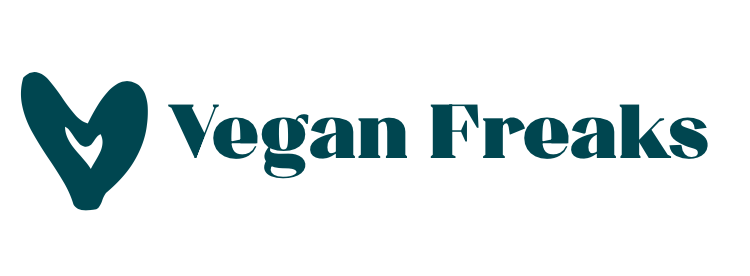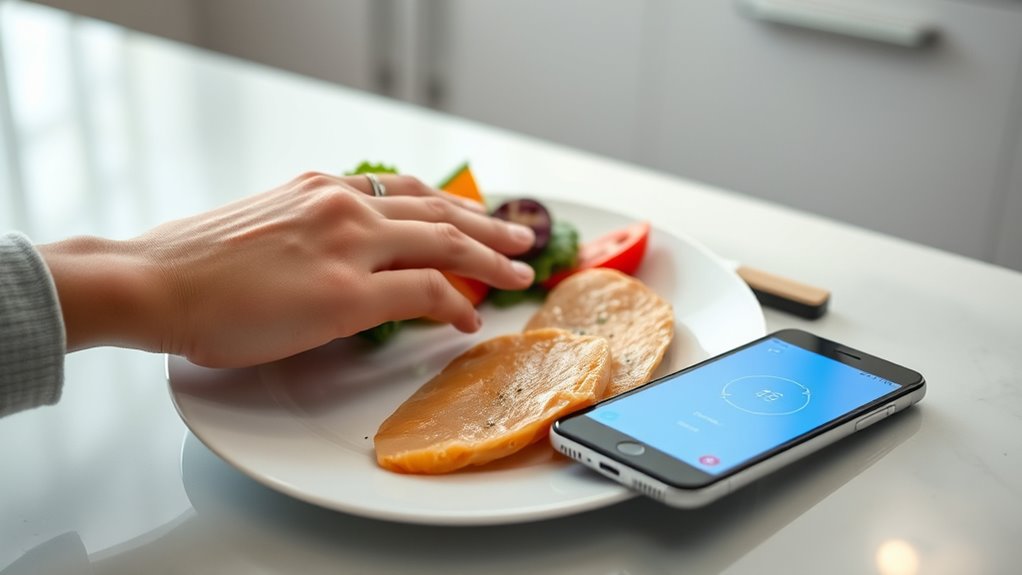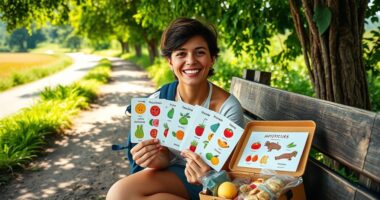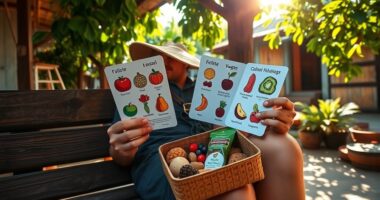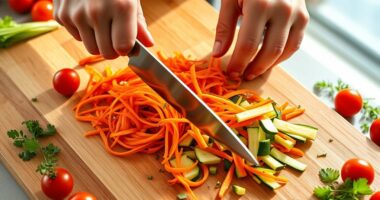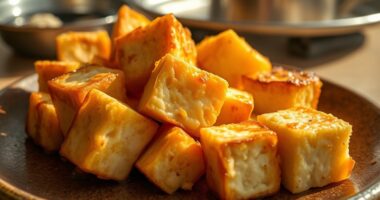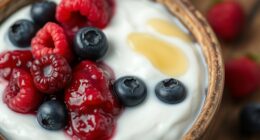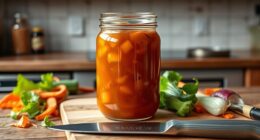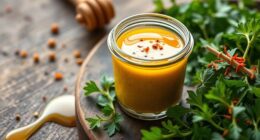To master portion control, use your hand to gauge servings—your palm for protein, a fist for carbs, and open palms for snacks. Combine this with plate visuals: fill half with vegetables, a quarter with lean protein, and a quarter with grains. Apps can help track portions via phone scans and photos for real-time feedback. Using these simple tools regularly makes smart eating second nature, and there’s more tips to help you become a pro at managing portions.
Key Takeaways
- Use your hand as a simple guide for estimating protein, carbs, snacks, and vegetables without measuring tools.
- Employ phone apps to scan barcodes and log meals, providing visual portion feedback and calorie counts.
- Fill half your plate with vegetables, a quarter with lean protein, and a quarter with grains for balanced meals.
- Combine hand, phone, and plate methods to develop intuitive portion control and healthier eating habits.
- Visual tools streamline meal planning, promote portion awareness, and support long-term dietary and health goals.

Understanding portion sizes can be challenging, but visual tools make it easier to manage your servings. When you’re trying to stay on top of your meal planning or calorie counting, knowing exactly how much food to eat becomes essential. Using your hand, phone, and plate as visual guides helps you develop a better sense of appropriate portions without constantly measuring or weighing everything. These simple tools act as quick references, enabling you to make smarter choices during busy days or when dining out. Incorporating visual portion guides into your routine can further enhance your ability to control servings effectively. Your hand is a versatile and convenient portion control tool. For example, a serving of protein, like chicken or fish, should be roughly the size of your palm. A cup of cooked pasta or rice aligns with your closed fist. When it comes to snacks such as nuts or trail mix, a handful is a good measure—about the size of your open palm. Vegetables and fruits, which are typically lower in calories but high in nutrients, can be piled onto your plate until it looks full but not overflowing, helping you avoid overeating. Using your hand as a guide simplifies meal planning because you don’t need to carry around measuring cups or rely solely on calorie counting apps. Instead, you develop an intuitive understanding of appropriate portions, which makes sticking to your dietary goals more manageable. Your phone can also be a powerful visual tool. Many apps allow you to scan barcodes or log meals with pictures, providing instant feedback on portion sizes and calorie counts. Some apps even offer visual portion estimates based on uploaded photos, so you can compare your servings to recommended sizes without tedious calculations. This approach streamlines meal planning, especially when you’re trying to balance calories throughout the day. By regularly tracking your intake with your phone, you gain insights into your eating habits, making it easier to adjust portion sizes in real-time and stay aligned with your health goals. Finally, your plate itself can serve as a visual guide for portion control. Filling half your plate with vegetables, a quarter with lean protein, and the remaining quarter with grains or starches helps you create balanced meals without the need for measuring. This visual method supports both meal planning and calorie counting, ensuring you get the right nutrients without exceeding your daily limits. Over time, these visual cues become second nature, helping you develop healthier eating habits and better control over your portions. Combining these tools—your hand, phone, and plate—creates a simple yet effective system that empowers you to eat smarter, stay on track, and achieve your health goals with confidence.
Frequently Asked Questions
Can Hand-Based Portions Work for Children or People With Different Hand Sizes?
Hand-based portions can work for children and people with different hand sizes because they adapt to age differences. You can use your hand as a flexible guide, adjusting for smaller or larger hands. While it’s a useful visual tool, keep in mind that hand size varies, so it’s helpful to learn typical portion sizes for different age groups. This way, you guarantee everyone gets appropriate portions, regardless of hand size.
Are Digital Tools or Apps Better Than Visual Cues for Portion Control?
Think of digital tools and apps as a GPS guiding your portion control journey, while visual cues are like a map you carry in your pocket. Digital tech offers precise tracking, making it easier to form healthy habits through consistent reminders and data. For habit formation, tech integration often proves more effective, especially for multitasking lifestyles. But, visual cues remain simple, accessible, and quick, serving as handy tools for immediate portion awareness.
How Do Portion Visuals Adapt for Specific Diet Plans Like Keto or Vegan?
When adapting portion visuals for keto or vegan diets, you can customize them to highlight specific foods and macronutrient ratios, ensuring meal plan compatibility. Use your hand, phone, or plate as visual cues tailored to each plan, emphasizing low-carb or plant-based options. This customization makes it easier to stick to your diet goals, providing clear, practical guidance that aligns perfectly with your dietary preferences and restrictions.
Can Portion Control Visuals Help With Emotional or Binge Eating?
Portion control visuals can really support your efforts with emotional eating by boosting mindful eating and emotional awareness. When you use your hand, phone, or plate as a visual guide, you become more aware of your hunger cues and portion sizes. This helps you slow down, recognize emotional triggers, and avoid bingeing. Over time, these visuals encourage healthier habits and help you develop a more balanced, intuitive relationship with food.
Are There Any Risks of Overeating When Using Visual Portion Cues?
Imagine your portion cues are like a lighthouse guiding ships—clear and helpful. However, if you’re not careful, misinterpretation hazards can lead to overeating risks, like overestimating what you need. You might accidentally serve too much or rely solely on visuals, missing your body’s actual signals. That’s why it’s essential to stay mindful and use these tools as guides, not strict rules, to avoid overeating.
Conclusion
Using your hand, phone, and plate as visual cues makes portion control feel natural—like having your own personal guide. Just like a compass points the way, these tools help you navigate your meals with confidence. Remember, small adjustments can lead to big health benefits over time. So, get creative and practice these simple tricks daily. Before you know it, portion control will become second nature, guiding you toward healthier habits effortlessly.
